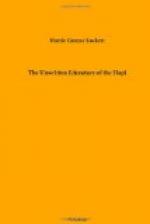As the athletes, one at a time, joined him they fell into a procession and, led by the flower bedecked individual, they moved gracefully in a circle to the rhythmic time of a festive chant and the accompaniment of the cow bell. When the last racer had arrived, they were led in a sort of serpentine parade toward the plaza. But before they reached that point they encountered a waiting group of laughing women and girls in bright-colored shawls, whose rollicking role seemed to be that of snatching away from the young men the stalks of green corn, squash, and gourds they had brought up from the fields below. The scene ended in a merry skirmish as the crowd dispersed.
Later, Dr. Cummings unobtrusively followed the tracks of the priests back along their sunrise trail and out across the desert for more than two miles, to find there a simple altar and nine fresh prayer-sticks.
About noon occurs the snake washing in the kiva. This is not for the public gaze. If one knows no better than to try to pry into kiva ceremonies, he is courteously but firmly told to move along.
A few white men have been permitted to see this ceremony, among them, Dr. Fewkes; an extract from his description of a snake washing at Walpi follows:[30]
[Footnote 30: Fewkes, J.W., Op. cit.]
“The Snake priests, who stood by the snake jars which were in the east corner of the room, began to take out the reptiles and stood holding several of them in their hands behind Supela (the Snake Priest), so that my attention was distracted by them. Supela then prayed, and after a short interval, two rattlesnakes were handed him, after which venomous snakes were passed to the others, and each of the six priests who sat around the bowl held two rattlesnakes by the necks with their heads elevated above the bowl. A low noise from the rattles of the priests, which shortly after was accompanied by a melodious hum by all present, then began. The priests who held the snakes beat time up and down above the liquid with the reptiles, which, although not vicious, wound their bodies around the arms of the holders.
“The song went on and frequently changed, growing louder, and wilder, until it burst forth into a fierce, blood-curdling yell, or war cry. At this moment the heads of the snakes were thrust several times into the liquid, so that even parts of their bodies were submerged, and were then drawn out, not having left the hands of the priests, and forcibly thrown across the room upon the sand mosaic, knocking down the crooks and other objects placed about it. As they fell on the sand picture, three Snake priests stood in readiness, and while the reptiles squirmed about or coiled for defense, these men with their snake whips brushed them back and forth in the sand of the altar. The excitement which accompanied this ceremony cannot be adequately described. The low song, breaking into piercing shrieks, the red-stained singers, the




